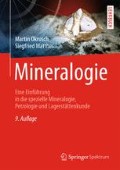Zusammenfassung
Im elementaren Zustand treten in der Natur etwa 20 chemische Elemente auf. Darunter befinden sich gediegene (ged.) Metalle, Metalloide (Halbmetalle) und Nichtmetalle. Die Metalle sind meistens legiert: Sie neigen zur Mischkristallbildung, z. B. (Au, Ag). Die wichtigsten Vertreter sind in Tabelle 4.1 zusammengestellt.
Access this chapter
Tax calculation will be finalised at checkout
Purchases are for personal use only
Preview
Unable to display preview. Download preview PDF.
Weiterführende Literatur
Anthony JW, Bideaux RA et al. (1990) Handbook of mineralogy, vol I: Elements, sulfides, sulfosalts. Mineral Data Publ, Tucson/Arizona
Anthony JW, Bideaux RA, Bladh KW, Nicholls MC (2000) Handbook of mineralogy. Diamond. Mineralogical Society of America
Butt CRM, Hough RM (2009) Why gold is valuable. Elements 5:277–280
Cobley CM, Xia Y (2009) Gold and nanotechnology. Elements 5:309–313
Geim AK (2008) Wunderstoff aus dem Bleistift. Spektrum Wiss August 2008, 86–93
Guerney JJ, Helmstaedt HH, le Roex AP, Nowicki TE, Richardson SH, Westerlund KJ (2005) Diamonds: Crustal distribution and formation processes in time and space and an integrated deposit model. Econ Geol 100th Anniversary vol, p 143–177
Harlow GE (ed) (1998) The nature of diamonds. Cambridge University Press, Cambridge
Harlow GE, Davies RM (2005) Diamonds. Elements 1:67–109
Heaney PJ, Vicenzi EP, De S (2005) Strange diamonds: The mysterious origins of carbonado and framesite. Elements 1:85–89
Hemley RJ, Chen Y-C, Yan C-S (2005) Growing diamond crystals by chemical vapor deposition. Elements 1:105–108
Hough RM, Butt CRM, Fischer-Bühner J (2009) The crystallography, metallography and composition of gold. Elements 5:297–302
Huss GR (2005) Meteoritic nanodiamonds: Messengers from the stars. Elements 1:97–100
Mungall JE, Meurer WP (eds) (2004) Platinum group elements: Petrology, geochemistry, mineralogy. Canad Mineral 42:241–694
Ogasawara (2005) Microdiamonds in ultrahigh-pressure metamorphic rocks. Elements 1:91–96
Stachel T, Brey GP, Harris JW (2005) Inclusions in sublithospheric diamonds: Glimpses of deep Earth. Elements 1:73–78
Walshe JL, Cleverley JS (2009) Gold deposits: Where, when and why. Elements 5:288–295
Zitierte Literatur
Cabri LJ, Harris DC, Weiser TW (1996) The mineralogy and distribution of platinum group minerals (PGM) in placer deposits of the world. Explor Mining Geol 5:73–167
El Goresy A, Gillet P, Chen M, Kunstler F, Graup G, Stähle V (2001) In situdiscovery of shock-induced graphite-diamond phase transition in gneisses from the Ries crater, Germany. Am Mineral 86:611–621
El Goresy A, Dubrovinsky LS, Gillet P, Mostefaoui S, Graup G, Drakopoulos M, Simionovici AS, Swamy V, Masaitis VL (2003) A novel cubic, transparent and superhard polymorph of carbon from the Ries and Popigai craters: Implications to understanding dynamic-induced natural high-pressure phase transitions in the carbon system. LPSC 34
El Goresy A, Dubrovinsky LS, Gillet P, Mostefaoui S, Graup G, Drakopoulos M, Simionovici AS, Swamy V, Masaitis VL (2003) A new natural, superhard transparent polymorph of carbon from the Popigai impact crater, Russia. CR Geoscience 335:889–898
Ernst WG (1976) Petrologic phase equilibria. Freeman, San Francisco Fehr T, Hochleitner R, Weiss S (1995) Sensationell: natürliche Platin- Kristalle aus Sibirien. Lapis 20(10):44–46
Foote AE (1891) A new locality for meteoritic iron with a preliminary notice on the discovery of diamonds in the iron. Amer J Sci 42: 413–417
Klein C, Hurlbutt Jr. CS (1985) Manual of mineralogy (after James D. Dana). 20th edn. Wiley, New York
Kroto HW, Heath JR, O’Brien SC, Curl RF, Smalley RE (1985) C60: Buckminsterfullerene. Nature 318:162–163
Medenbach O, Wilk H (1977) Zauberwelt der Mineralien. Sigloch edition. Künzelsau Thalwil Salzburg
Ramdohr P, Strunz H (1978) Klockmanns Lehrbuch der Mineralogie, 16. Aufl. Enke, Stuttgart
Ringwood AE (1960) The Novo Urei meteorite. Geochim Cosmochim Acta 20:1–2
Schmitt RT, Lapke C, Lingemann CM, Siebenschock M, Stöffler D (2005) Distribution and origin of impact diamonds in the Ries Crater, Germany. In: Kenkmann T, Hörz F, Deutsch H (eds) Large meteorite impacts III. Geol Soc America Spec Paper 384: 1–16
Shcheka GG, Lehman B, Gierth E, Gömann K, Wallianos A (2004) Macrocrystals of Pt-Fe alloy from the Kondyor PGE placer deposit, Khabarovskiy Kray, Russia: Trace element content, mineral inclusions and reaction assemblages. Canad Mineral 42:601–617
Shumilova TG, Isaenko SI, Divaev FK, Akai J (2012) Natural carbon nanofibers in graphite. Mineral Petrol 104:155–162
Author information
Authors and Affiliations
Corresponding author
Rights and permissions
Copyright information
© 2014 Springer-Verlag Berlin Heidelberg
About this chapter
Cite this chapter
Okrusch, M., Matthes, S. (2014). Elemente. In: Mineralogie. Springer-Lehrbuch. Springer Spektrum, Berlin, Heidelberg. https://doi.org/10.1007/978-3-642-34660-6_4
Download citation
DOI: https://doi.org/10.1007/978-3-642-34660-6_4
Published:
Publisher Name: Springer Spektrum, Berlin, Heidelberg
Print ISBN: 978-3-642-34659-0
Online ISBN: 978-3-642-34660-6
eBook Packages: Life Science and Basic Disciplines (German Language)

